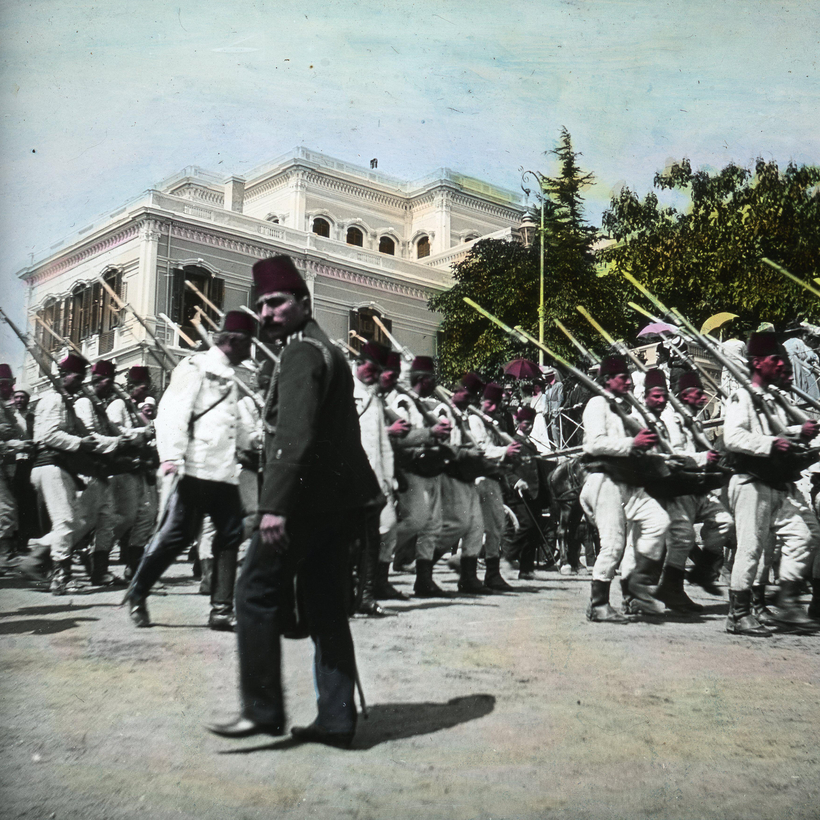It is difficult to define “empire” precisely, because every empire was different. But for the Ottomans and their unraveling, Joshua Cohen’s recent novel, The Netanyahus, will do: “It was the function of empires to furnish a common identity to disparate peoples and whenever they couldn’t, they failed.” In 1922, this was to be the Ottoman lot.
From humble late-13th-century origins in modern-day Turkey, the Ottomans rose to take Constantinople in 1453, burying the eastern remnant of the Roman Empire, and by the 17th century ruled much of the Mediterranean basin. The question of how the Ottoman edifice collapsed is typically answered with reference to its beginnings and long, fascinating history. In The Last Days of the Ottoman Empire, Ryan Gingeras lands straight in 1918 and the empire’s final innings in the 20th century, revising the period’s perception as “postscript” and underlining its confusions, contradictions, and uncertain outcome.
For Gingeras, the fall of 1918 “marked the beginning of an exceedingly complex period of warfare and negotiation,” as well as the profound loss one imagines Pericles had in mind 2,500 years ago: “You now hold your empire down by force: it may have been wrong to take it; it is certainly dangerous to let it go.” Just how dangerous for Ottoman subjects would become shockingly clear.

In 1908, Abdülhamīd II had bowed to pressure from the Committee of Union and Progress—C.U.P., or Young Turks—and restored the Ottoman constitution. The empire’s first and last ruling party, the Young Turks were either charismatic idealists or “yesterday’s school children,” depending on whom you asked. Authoritarian tendencies; the misguided Ottoman-German Alliance, in 1914; irreconcilable opinions about what constituted Ottomanness; and communal violence would doom the party, which disbanded within days of signing the Armistice of Mudros, in October 1918.
While few mourned the Young Turks, the accepted reasons for their failure ranged widely. For some, they were incompetent adventurers; for conservative observers, they were morally corrupt.
A global drive for self-determination intensified internal pressures. Gingeras contrasts Woodrow Wilson’s sunny view of settling Central Europe’s so-called national questions with the gloomier predictions of his secretary of state, Robert Lansing, for whom the matter was “simply loaded with dynamite.” It turned on identity, and mired virtually every religious and ethnic community—Muslims and Christians, Turks, Greeks, Armenians, Arabs and Kurds—in bloodshed and atrocity.

As Gingeras notes bleakly, “In this respect, one may be able to tell a relatively inclusive history of the empire’s end. The violence of this era was typically unforgiving and left very few communities unscathed.” Gingeras wisely and ably brings us into—rather than adjudicates—these tragic years.
Wilson’s principle of self-determination was generally understood “in a majoritarian light,” writes Gingeras. “Minorities, at best, were to be tolerated. Yet given the country’s inherent diversity, as well as the chaos and dislocation brought on by the war, the question of who was in the majority could not always be easily answered.” The pattern of violence and counter-violence is well established. Gingeras excels, however, at the jumble of rumor and reality that composed its logic.
There is no shortage of examples. In May 1922, as the triumphant National Movement entered the port of Foça and captured Greek soldiers were bayoneted or drowned with horrified throngs looking on, an older woman called out: “‘Oh son … why are you doing this?’ ‘Do you know what they have done?’ one Nationalist soldier replied. ‘They killed our pregnant women in Manisa, ripped their bellies apart, bayoneted their children and played with their bodies’. Nothing like that, however, had happened in Foça,” Gingeras laments.
The young Greek and Byzantine historian and special correspondent for The Manchester Guardian, Arnold Toynbee, met survivors of killings and mass expulsions outside Bursa the year before who knew their oppressors personally. They were “ordinary Greek civilians … under the brutalizing influence of the war and the encouragement of the Greek army of occupation.” The grim cycle had an unstoppable quality.
Even well-meaning attempts at restitution tended to exacerbate tensions. Displaced Armenians and Greeks returned to find their homes occupied by poor Muslim refugees. Official suggestions were less than helpful. When war-weary Kosovars and Macedonians declined to make way in the town of Bafra, the governor, Gingeras relates, “advised returning Greeks to instead ‘go and live with the Albanians and become their servants.’”
Eliminating one’s enemies was easier, it seems, than removing the vestiges of empire. “Despite an official culture that tended to demean all things associated with the Ottoman past,” Gingeras observes, “admiration for imperial history proved resilient.” In Turkey, the Ottoman script defied linguistic reforms and outlived Mustafa Kemal.
Time would achieve what Kemal could not. Vanishingly few Turks understand Ottoman. Where the Turkish president Recep Erdoğan openly admires the Ottomans, state schools in Middle Eastern and Balkan countries teach their era as “a time of extreme backwardness and oppression,” according to Gingeras. “Ironically, many of those who helped enshrine this reading of history were scholars, officers and officials who had served in the Ottoman administration.” The Ottoman sultans were outsiders to be expelled, like the British from India.
The Last Days of the Ottoman Empire is superb and illuminating. Its only demerit, to the extent it has any, lies inevitably in its approach—the focus on 1918–22 leaves unanswered questions about the meaning and tenacity of imperial loyalties and culture.
For nostalgia for the past was not strictly for diehards. To read Yahya Kemal’s poem “1918” is to share in his sorrow: “Those who died, died. We suffered with those who remained. We are now a despised community in the fatherland. Those who died were saved from this turmoil in the end. And behind their eyelids is the old fatherland.”

Max Carter is vice-chairman of 20th- and 21st-century art at Christie’s in New York


